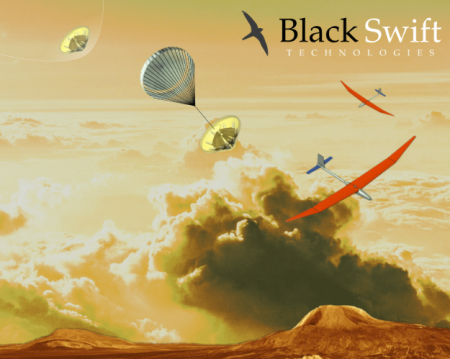June 29, 2018 – In the last two weeks, the public has learned more about the atmosphere of Venus and about NASA’s ambition to fly an unmanned drone aircraft through it. Black Swift Technologies (BST) builds aerial survey technology for use here on Earth. And now with a new NASA contract in hand, will build an aerial surveillance vehicle to roam the skies of Venus.
The atmosphere of Venus is extremely turbulent with high winds that can reach 360 kilometers (220 miles) per hour. These types of speeds largely occur in the upper atmosphere. Further down, wind speeds decline to as low as 10 kilometers (6 miles) per hour at the surface. The upper atmosphere also experiences a phenomenon called super-rotation, circling the planet the equivalent of every four Earth days, while the planet below rotates in a retrograde fashion turning on its axis once every 224 Earth days.
Surface temperatures of the planet reach 467 Celsius (872.6 Fahrenheit) degrees. Atmospheric pressure at the surface is 92 times greater than that of Earth. But there is a sweet spot in that atmosphere between 50 and 65 kilometers above the surface where pressures and temperatures are very Earth-like. It is there, described by NASA as the most Earthlike environment in our Solar System other than the one here at home, that the agency wants to insert a Black Swift-built aerial drone to do target sampling and continuous monitoring of the planet and its atmosphere for an extended period of time.
Black Swift’s glider would fly through the atmosphere of Venus both day and night. Using a technique called dynamic soaring, the aircraft would harness kinetic energy by flying through atmospheric boundary layers where it would take advantage of different wind speeds. Dynamic soaring is observed in nature with birds like the albatross. This species can stay aloft for days without ever flapping its wings because it rides along the boundary layers of our atmosphere using the kinetic energy to float effortlessly.
If an albatross or the Black Swift aerial vehicle were to remain at only one elevation level in a constant wind, gravity and aerial drag would slowly cause both to lose altitude. But by harvesting the kinetic forces of changes in wind speed at boundary layers the albatross and the Black Swift aircraft recover elevation and speed to remain aloft indefinitely. Of course, the Black Swift technology will have to make it to the Venus sweet spot which will require some pretty inventive deployment methods similar to the entry vehicle depicted in the illustration below.
On Venus, a descent into the atmosphere will have to deal with ferocious winds as well as high atmospheric pressures. There are no lessons to be learned from Mars’ descent technologies which have been designed for very different conditions. And if Black Swift should succeed in deploying an aerial surveillance drone on Venus, it may not be too far in the future for us to consider deploying even more robust versions to fly in the turbulent atmospheres of the gas giants of the outer Solar System.
















